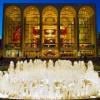
Eli Broad, the home construction tycoon who became a driving force behind many of the physical and cultural changes in Los Angeles since the 1960s, died at Cedars-Sinai Medical Center last Friday afternoon. He was 87; the cause of death was not disclosed.
Born in New York City June 6, 1933, Broad grew up in Detroit as an only child. He graduated from Michigan State University and became a certified public accountant at 20. In 1957, he co-founded Kaufman & Broad, which soon became the biggest independent single-family home building company in the country, expanding into Arizona and California. By 1963, he had moved to Southern California with his wife Edythe and started collecting modern and Pop art.

To gauge at a glance the influence that Broad has had over the city, take a walk on Grand Ave. downtown from the corner of 1st Street south. To your right is Walt Disney Concert Hall, a project that looked dead in the water in the mid-1990s until Broad launched a $135 million fundraising drive to restart the campaign to get it built. Further down the street on the left is the Museum of Contemporary Art (MOCA), of which he became the founding chairman in the late 1970s.
Across from MOCA on the right is Broad’s own art museum, simply called The Broad, which he had built to house his extensive collection of modern art. And finally, over your shoulder on the left, still under construction, are the massive high-rising towers of the Grand Avenue Project that are redefining the downtown skyline, the capstone of Broad’s vision of turning Grand Ave. into a West Coast Champs Elysees.

Elsewhere in the region, Broad donated money to UCLA to build a fine arts complex and to Cal Tech to found a biological sciences center. The main theatre of Santa Monica College’s performing arts center bears the name, The Broad Stage.
The willful Broad was not a stranger to conflict, and he knew it: his 2012 memoir is entitled The Art of Being Unreasonable. Having pledged $50 million to build a contemporary art wing to the Los Angeles County Museum of Art on Wilshire Blvd., he insisted on having it named after him (the Broad Contemporary Art Museum), but his collection ultimately ended up downtown at The Broad. He famously sparred with Frank Gehry, the architect of Disney Hall, over its design, but when the hall finally opened in 2003, they shared the triumph.





